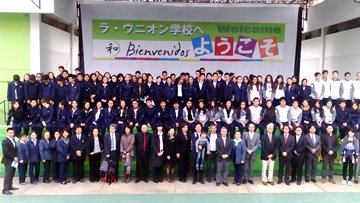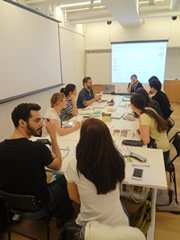Looking Back on a Year with a Four-Person Team
The Japan Foundation, Sao Paulo
FUKUSHIMA Seiji, NAKAJIMA Eriko, YOSHIOKA Chisato, NOMURA Yumiko
There have been four Japanese-Language Specialists dispatched to the Japan Foundation, Sao Paulo (hereinafter “FJSP”) since last year. We are now headed into our second year with the same team. Last year we wrote about our operational details, so this year, each of us will write about the thing that left the greatest impression on us.
First Writer: NOMURA Yumiko (Japanese-Language Specialist in Charge of Higher Educational Institutions in Brazil)
The Japanese-language course which began in April 2016 for science and engineering students at five federal universities in Brazil is still being offered as “Languages without Borders” (Idiomas sem Fronteiras, in Portuguese) Japanese-language course. The course is being taught by students majoring in the Japanese language at those federal universities, and a two-week training program was held for those student tutors at the Japan Foundation Japanese-Language Institute, Kansai in January 2017. The purpose of the training program was to offer the student tutors a direct experience of Japan to deepen their understanding of the state of Japan and its culture while allowing them to share their questions and concerns regarding leading classes. Due to the size of Brazil, it is normally difficult to bring student tutors from each region together, so the two-week training served as a very meaningful opportunity for the students to share information and their different teaching methods. Before the Japanese cultural studies, the student tutors explained that they did not know how they should teach about Japan, as a place they had never been, and lacked confidence, but after the training, they noted that they had gained the confidence to teach and had begun to develop a grasp of the culture, giving a clear sense of the value of the training.
The student tutors are expected to continue to lead Japanese-language education at the federal universities in Brazil moving forward, and as the Japanese-Language Specialist in charge of providing support for higher educational institutions, my days are filled with joy whenever I can provide even a small amount of support for their growth.
Second Writer: YOSHIOKA Chisato (South America Advisor)
I visited nine countries to carry out surveys in the first half of 2016, including Peru, Argentina, Paraguay, Uruguay, Colombia, Venezuela, Chile, Ecuador, and Bolivia (in order of visit). I was able to learn about the reality on the ground by speaking with locals involved in Japanese-language education and by observing actual classes. I am currently polishing up my report on the state of Japanese-language education in the Spanish-speaking countries of South America based on the data obtained during the surveys.
The Second Liaison Conference on Japanese-Language Education in Spanish-Speaking South America (RSJ) was held in the latter half of 2016. One participant attended from each of the nine countries to give presentations on the state of Japanese-language education in their respective countries and share the problems they face. At the end of the meeting, each participant selected themes to focus the initiatives in their country on over the coming year, including Japanese-language education related events, teacher training and development, and information exchange and sharing. I look forward to the activity reports from the third conference.
The South America Advisors plan to carry out activities based on those policies for each country, and I hope that the teachers, institutions, and organizations make good use of the Advisors for networking and improving the Japanese-language education environment in each country.

RSJ participants with students from el Colegio La Unión in Peru
Third Writer: NAKAJIMA Eriko (Japanese-Language Specialist in Charge of the Japanese-Language Course)
The Move to Japan House
Now that the new Japan House has been opened in Sao Paulo, the JF "Marugoto: Japanese Language and Culture" Japanese-language course will be held in the seminar room of that facility. There is currently a great deal of interest from those who previously were not necessarily interested in Japan or the Japanese culture, and we are receiving numerous inquiries.
Intermediate Level Enrichment

Intermediate 1A - Classroom scene
We categorize local Japanese-language schools by level for the Japanese-language course, and over half of the classes for the course in 2017 reached the intermediate level (B1) or greater. We are trying the following classroom measures in order to give learners the ability to overcome problems understanding Japanese on their own, as “independent language learners.” (1) Stronger monitoring: record conversational roleplaying to allow students to discuss what they did well and what needs improvement. (2) Promoting autonomous learning: in addition to self-management of studies using a portfolio, we provide time for the students to speak with other students and reflect on their Japanese studies after completing each topic. (3) Providing opportunities for practice: the students participate in exchange events with Japanese people living in Brazil each semester (intercultural exchange events) to converse and give presentations in Japanese.
Comments from the students include that the new approach is completely different to how they previously studied, and that they are now able to actually use Japanese as they learn it.
Fourth Writer: FUKUSHIMA Seiji (Japanese-Language Senior Specialist)
My activities for FY2016 included attending two FJSP hosted teacher training programs, three learner support events, 10 domestic trips in Brazil as a Japanese-Language Chief Advisor, and three trips to other countries in South America. I met countless teachers, learners, and users of the Japanese language during that time, and was amazed by the diversity in Brazil and South America. The learners ranged from young children to the elderly, and the teaching methods used were also diverse, such as grammar-building, task-oriented, and content-focused. The textbooks used also included both textbooks for Japanese-language learning and textbooks for learning Japanese as the native language, such as are used in Japan. In addition to the motivations to learn Japanese seen everywhere in the world, such as to gain the ability to use Japanese, to have fun learning it, or an interest in Japanese culture, there were many other motivations such as Japanese ethnicity or a desire to carry on the Japanese culture. Japanese-language education in Brazil began with education for children of Japanese descent, but has since become part of Brazilian history as the ethnic Japanese community transformed over the years. The diversity of Japanese-language education I described above serves as a cross-section of the current state of Japanese language in Brazilian society, and as a reflection of the way the language has become woven into that society. The question remains of how to further develop Japanese into the future as a cultural and linguistic resource with a long history as part of Brazilian society. I believe that answering this question is the key to the future of Japanese-language education in Brazil.
- What We Do Top
- Arts and Cultural Exchange [Culture]
- Japanese-Language Education Overseas [Language]
- Japanese-Language Education Overseas [Language] Top
- Learn Japanese-language
- Teach Japanese-language
- Take Japanese-Language Test
- Know about Japanese-language education abroad
- The Japanese-Language Institute, Urawa
- The Japanese-Language Institute, Kansai
- Japanese-Language Programs for Foreign Specified Skilled Worker Candidates
- Japanese Language Education for Japanese Children Resident Overseas and for the Descendants of Migrants
- Archives
- Japanese Studies and Global Partnerships [Dialogue]
- JF digital collection
- Other Programs / Programs to Commemorate Exchange Year
- Awards and Prizes
- Publications
